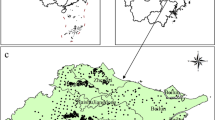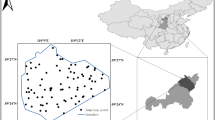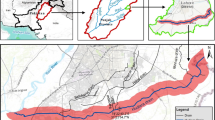Abstract
Purpose
With the development of heavy industry, urban soil suffers serious pollution, which threatens the sustainable development of cities. Understanding the spatial distribution characteristics of surface soil pollution aids in pollution prevention and control and promotes sustainable development.
Materials and methods
We use China’s Baotou as an example. Based on the data of 2820 sampling points in main urban areas and some suburban areas of Baotou, we constructed a relationship network model for sampling points in surface soil by using the complex network method. We combined the network method with spatial geographic information to analyze the spatial agglomeration characteristics of the surface soil pollution in Baotou China.
Results and discussion
Sampling points at Dalahai Village (including 506D, 538B, and 538D) and Hayenaobao Village (including 509C, 541A, and 541C), Puerhantu Town within the Kundulun District have the most serious pollution problems, and they are all concentrated in the tailings dam. Sampling points 328D and 544A are scattered in the Leng Community, Kunhe Town, Kundulun District and Changhan Village, Haringer Township, Jiuyuan District, but they have a close co-anomaly relationship with the tailings dam. We suggest that these areas should be unified to give priority to pollution control. There is an obvious difference for Al2O3, B, Hg, and U, which are abnormal in the power plant ash storage pools, but normal at the tailings dam. Consequently, pollution control for power plant ash storage pools needs to be different from pollution control at the tailings dam. Sampling points at the Fengying Community (including 580A and 580B), Kunhe Town, Kundulun District, and Gaoyoufang Village (579D and 643B), Rare Earth Road, Qingshan District as well as other sampling points upstream of the Kundulun River have a close co-anomaly relationship with the tailings dam. It is necessary to strengthen the purification treatment of sewage upstream of the Kundulun River to reduce the spread of pollutants.
Conclusions
These results provide a theoretical basis for the government to formulate specific cross-regional collaborative governance measures.






Similar content being viewed by others
References
Ajmone-Marsan F, Biasioli M (2010) Trace elements in soils of urban areas. Water Air Soil Pollut 213(1–4):121–143
Bai Y, Wang M, Peng C, Alatalo JM (2016) Impacts of urbanization on the distribution of heavy metals in soils along the Huangpu River, the drinking water source for Shanghai. Environ Sci Pollut Res 23(6):5222–5231
Barigozzi M, Fagiolo G, Mangioni G (2011) Identifying the community structure of the international-trade multi-network. Physica A 390(11):2051–2066
Barrat A, Barthelemy M, Pastor-Satorras R, Vespignani A (2004) The architecture of complex weighted networks. Proc Natl Acad Sci U S A 101(11):3747–3752
Blundell A, Hannam JA, Dearing JA, Boyle JF (2009) Detecting atmospheric pollution in surface soils using magnetic measurements: a reappraisal using an England and Wales database. Environ Pollut 157(10):2878–2890
Blondel VD, Guillaume JL, Lambiotte R, Lefebvre E (2008) Fast unfolding of communities in large networks. J Stat Mech: Theory Exp. https://doi.org/10.1088/1742-5468/2008/10/P10008
Bodin O (2017) Collaborative environmental governance: achieving collective action in social-ecological systems. Science 357(6352):659
Bodin O, Robins G, McAllister RRJ, Guerrero AM, Crona B, Tengo M, Lubell M (2016) Theorizing benefits and constraints in collaborative environmental governance: a transdisciplinary social-ecological network approach for empirical investigations. Ecol Soc. https://doi.org/10.5751/ES-08368-210140
Bourliva A, Papadopoulou L, Aidona E, Giouri K (2017) Magnetic signature, geochemistry, and oral bioaccessibility of “technogenic” metals in contaminated industrial soils from Sindos Industrial Area, Northern Greece. Environ Sci Pollut Res 24(20):17041–17055
Chen GG, Liang XH, Zhou GH, Zhang M, Lin CH (2011) Grade division method for soil geochemical contamination and its application. Geol China 38(6):1631–1639 (in Chinese)
Chen TB, Zheng YM, Lei M, Huang ZC, Wu HT, Chen H, Fan KK, Yu K, Wu X, Tian QZ (2005) Assessment of heavy metal pollution in surface soils of urban parks in Beijing, China. Chemosphere 60(4):542–551
Chen X, Xia X, Zhao Y, Zhang P (2010) Heavy metal concentrations in roadside soils and correlation with urban traffic in Beijing, China. J Hazard Mater 181(1–3):640–646
Dayani M, Mohammadi J (2010) Geostatistical assessment of Pb, Zn and Cd contamination in near-surface soils of the urban-mining transitional region of Isfahan, Iran. Pedosphere 20(5):568–577
Emerson K, Nabatchi T, Balogh S (2012) An integrative framework for collaborative governance. J Public Adm Res Theory 22(1):1–29
Fan XH, Wang L, Xu HH (2016) Characterizing air quality data from complex network perspective. Environ Sci Pollut Res 23(4):3621–3631. https://doi.org/10.1007/s11356-015-5596-y
Fu S, Wei CY (2013) Multivariate and spatial analysis of heavy metal sources and variations in a large old antimony mine, China. J Soils Sediments 13(1):106–116
Galuszka A (2007) A review of geochemical background concepts and an example using data from Poland. Environ Geol 52(5):861–870
Gao XY, An HZ, Liu HH, Ding YH (2011) Analysis on the topological properties of the linkage complex network between crude oil future price and spot price. Acta Phys Sin 60(6):068902 (in Chinese)
Gauthier TD (2001) Detecting trends using Spearman’s rank correlation coefficient. Environ Forensic 2(4):359–362
Hu YN, Liu XP, Bai JM, Shih KM, Zeng EY, Cheng HF (2013) Assessing heavy metal pollution in the surface soils of a region that had undergone three decades of intense industrialization and urbanization. Environ Sci Pollut Res 20(9):6150–6159
Li HJ, Fang W, An HZ, Yan LL (2014) The shareholding similarity of the shareholders of the worldwide listed energy companies based on a two-mode primitive network and a one-mode derivative holding-based network. Physica A 415:525–532
Li YJ, Wang JY, Zheng CL, Shui LY, Yi M, Cai L (2011) Characteristics of heavy metal combined pollution in Baotou Tailing Dam and its neighboring regions. Metal Mine 419:137–148 (in Chinese)
Liao L, Liu HL, Su MX, Duan HL, Wang JF, Zhao LJ (2012) Geochemical characteristics of the soil from Baotou City, Inner Mongolia and its environmental assessment. Geol Explor 48(4):799–806 (in Chinese)
Matschullat J, Ottenstein R, Reimann C (2000) Geochemical background—can we calculate it. Environ Geol 39(9):990–1000
Mishra UC (2004) Environmental impact of coal industry and thermal power plants in India. J Environ Radioact 72(1–2):35–40
Perez-Sirvent C, Hernandez-Perez C, Martinez-Sanchez MJ, Garcia-Lorenzo ML, Bech J (2016) Geochemical characterisation of surface waters, topsoils and efflorescences in a historic metal-mining area in Spain. J Soils Sediments 16(4):1238–1252
Rodriguez-Seijo A, Andrade ML, Vega FA (2017) Origin and spatial distribution of metals in urban soils. J Soils Sediments 17(5):1514–1526
Simon E, Vidic A, Braun M, Fabian I, Tothmeresz B (2013) Trace element concentrations in soils along urbanization gradients in the city of Wien, Austria. Environ Sci Pollut Res 20(2):917–924
Sun P, Li YW, Zhang LK, Li YM, Wang WD, Yu WJ (2016) Heavy metal pollution in topsoil from the Baotou industry area and its potential ecological risk evaluation. Rock and Mineral Analysis 35(4):433–439 (in Chinese)
Tang JJ, Wang YH, Wang H, Zhang S, Liu F (2014) Dynamic analysis of traffic time series at different temporal scales: a complex networks approach. Physica A 405:303–315
Tang Z, Engel BA, Pijanowski BC, Lim KJ (2005) Forecasting land use change and its environmental impact at a watershed scale. J Environ Manag 76(1):35–45
Tume P, King R, Gonzalez E, Bustamante G, Reverter F, Roca N, Bech J (2014) Trace element concentrations in schoolyard soils from the Talcahuano, Chile. J Geochem Explor 147:229–236
Wang XB, Ge JP, Wei WD, Li HS, Wu C, Zhu G (2016) Spatial dynamics of the communities and the role of major countries in the international rare earths trade: a complex network analysis. PLoS One 11(5):e0154575. https://doi.org/10.1371/journal.pone.0154575
Wei BG, Yang LS (2010) A review of heavy metal contaminations in urban soils, urban road dusts and agricultural soils from China. Microchem J 94(2):99–107
Xia JQ, Lou YM (2006) Definition and three evaluation guidelines of soil contamination. J Ecol Rural Environ 22(1):87–90 (in Chinese)
Xu Q, Liu XD, Tang QF, Liu JC, Zhang LL (2011) A multi-element survey of surface soil and pollution estimate in Baotou city. Arid Land Geogr 34(1):91–99 (in Chinese)
Xu Q, Zhang LX, Liu SH, Liu XD, Zhang LJ (2008) Heavy metal pollution of surface soil and its evaluation of potential ecological risk: a case study of different functional areas in Baotou City. J Nat Dis 17(6):6–12 (in Chinese)
Yang JY, Yu F, Yu YC, Zhang JY, Wang RH, Srinivasulu M, Vasenev VI (2017) Characterization, source apportionment, and risk assessment of polycyclic aromatic hydrocarbons in urban soil of Nanjing, China. J Soils Sediments 17(4):1116–1125
Yaylali-Abanuz G (2011) Heavy metal contamination of surface soil around Gebze industrial area, Turkey. Microchem J 99(1):82–92
Zhang JJ, Wang Y, Liu JS, Liu Q, Zhou QH (2015) Multivariate and geostatistical analyses of the sources and spatial distribution of heavy metals in agricultural soil in Gongzhuling, Northeast China. J Soils Sediments 16(2):634–644
Zhao Z, Hazelton P (2016) Evaluation of accumulation and concentration of heavy metals in different urban roadside soil types in Miranda Park, Sydney. J Soils Sediments 16(11):2548–2556
Zhong WQ, An HZ, Gao XY, Sun XQ (2014) The evolution of communities in the international oil trade network. Physica A 413:42–52
Zohar I, Teutsch N, Levin N, Mackin G, de Stigter H, Bookman R (2017) Urbanization effects on sediment and trace metals distribution in an urban winter pond (Netanya, Israel). J Soils Sediments 17(8):2165–2176
Zong YT, Xiao Q, Lu SG (2017) Magnetic signature and source identification of heavy metal contamination in urban soils of steel industrial city, Northeast China. J Soils Sediments 17(1):190–203
Acknowledgments
The authors would like to express their gratitude to Haizhong An, Xiaoqi Sun, and Xueyong Liu, who provided valuable suggestion. The authors would also like to thank AJE-American Journal Experts for their professional suggestions regarding the language usage, spelling, and grammar of this paper.
Funding
This research is supported by grants from the National Natural Science Foundation of China (Grant No. 41701121), the Beijing Youth Talents Funds (2017000020124G190) and the Fundamental Research Funds for the Central Universities (Grant No. 2-9-2017-041).
Author information
Authors and Affiliations
Corresponding author
Additional information
Responsible editor: Maxine J. Levin
Rights and permissions
About this article
Cite this article
Han, X., Li, H., Su, M. et al. Spatial network analysis of surface soil pollution from heavy metals and some other elements: a case study of the Baotou region of China. J Soils Sediments 19, 629–640 (2019). https://doi.org/10.1007/s11368-018-2057-5
Received:
Accepted:
Published:
Issue Date:
DOI: https://doi.org/10.1007/s11368-018-2057-5




